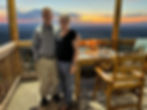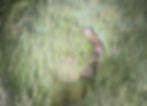Queen Elizabeth National Park--Uganda's Serengeti
- ghill1
- Jun 26, 2022
- 4 min read
Updated: Jul 12, 2022

A lioness sleeping in a tree greeted us as we arrived at Queen Elizabeth National Park.

The Enganzi Lodge overlooking Queen Elizabeth National Park was a luxurious place to come back to after a day of birding and dodging elephants in Queen Elizabeth National Park.
From the Bwindi Impenetrable Forest, we drove north, more or less paralleling the border with the Congo. It was another long drive, but by late afternoon we had arrived at our lodge overlooking Queen Elizabeth National Park, the largest national park in Uganda. As was the case with all of the lodges we stayed at in Uganda, the Enganzi Lodge was spectacular with a wonderful bungalow and a dining room with views of the national park.


The first elephant that we spotted in Uganda crossed the highway right next to us. Over the next two days, under the expert guidance of Johnnie, we got close to several elephants.
We didn't have time to linger at the lodge, however, because Johnnie heard that there was a lioness sleeping in a tree in the national park, about 15 minutes drive away. Sure enough, we joined a lineup of safari vehicles pulled off along a paved highway through the park and got nice views of the lion--the only clear views of lion that we had on this trip. As we were watching the lion, Johnnie noticed an elephant in the distance headed our way. It was our first elephant of the trip and we wanted a better view of it. Not to worry, the big pachyderm came right at us and crossed the highway only a couple of hundred feet away--stopping traffic as it walked across the road. Over the next two days, we would have lots of up-close interactions with elephants.

Queen Elizabeth National Park felt like east Africa with lots of big game including big herds of Uganda Kob . photo by Wendy Hood.
Queen Elizabeth National Park is the Serengeti of Uganda--the sort of park that Americans think of when they think of Africa. Most of the big game species of Africa were present: lions, leopards, hyena, giraffe, hippos, big herds of antelope. A few things are missing--no cheetah or rhino-- but it feels like wild Africa.

Lilac-breasted Roller was one of many birds we saw in Queen Elizabeth National Park.
The birds were diverse and interesting as well. One of the iconic birds of the savannas of east Africa is the beautiful Lilac-breasted Roller. We had seen these birds from a distance several time previously in our trip and then finally we got pretty close to a bird and i was able to get great views and photograph it.

Marabou Storks flew with the vultures at Queen Elizabeth National Park.
I mentioned vultures in my blog entry about Mburo National Park. There were even more big vultures in Queen Elizabeth NP (I think we had 25 in the air at once at one point). There was also another iconic carrion-eater of Africa--Marabou Storks. These birds would circle in the thermals with vultures. I said earlier that Lappet-faced Vulture may be the biggest flying bird (bird with the widest wingspan) I had ever seen. Marabou Stork would also be in that contest. They have a wingspan that is on par with Lappet-faced Vulture and Andean Condor. Later in the day, we saw yet another contender for bird with the widest wingspan--Great White Pelican.

Palm-nut Vultures will eat carrion, fish, and other forms of animal flesh, but a large proportion of their diet is the fruit of palms.
Another fantastic bird that I was very happy to see was the boldly plumaged black-and-white Palm- nut Vulture. As its name suggests, the fruits of palms makes up a large proportion of the diet of these Old World Vultures. We got several excellent views of Palm-nut Vultures in the Queen Elizabeth Park region.

One of the highlights of our trip to Queen Elizabeth National Park was a boat ride in the channel that connects Lake Edward and Lake George. The shoreline of this channel was packed with herds of big game and flocks of birds.
In the afternoon of our day in Queen Elizabeth National park we took our third boat ride in Uganda. This was a crowded double-decker tour boat in "the channel" between Lake Edward and Lake George. This wide channel is entirely contained within Queen Victoria National Park, and it was packed with wildlife. And the boat took us right up next to the animals.

Great White Pelicans...

Yellow-billed Storks, ...

Cape Buffalo joined dozens of other species of birds and mammals crowding the shore of the channel in Queen Elizabeth National Park.
Our visit to Queen Elizabeth National Park ended with a night drive. I didn't expect to see many or any birds on this trip, so I was surprised when we say numerous nightjars on the road. Most were Square-tailed Nightjars, but we also saw a couple Swamp Nightjars and a bird I had always wanted to see: Pennant-winged Nightjar. Unfortunately, the pennant-wing had not yet grown his pennant wings.

Square-tailed Nightjar.

Swamp Nighjar

Pennant-winged Nightjar.
The nightjars were fun, but the night really belonged to mammals. We watched hundred of Uganda Kob stream past. Johnnie spotted a Hyena wandering across the grasslands, and as we were trying to leave the park, a huge bull elephant defiantly blocked our path. Johnnie finally scared it off by dancing his green lazer pointer at its feet. Finally, we passed a grazing hippo next to the highway on the way home. Queen Elizabeth National Park was one of our favorite places in Uganda.


On a night-drive through Queen Elizabeth National Park, we enjoyed the only Hyenas that we saw on the trip as well as a grazing hippo, which you only see out of water at night. (hyena and hippo photos by Wendy Hood).